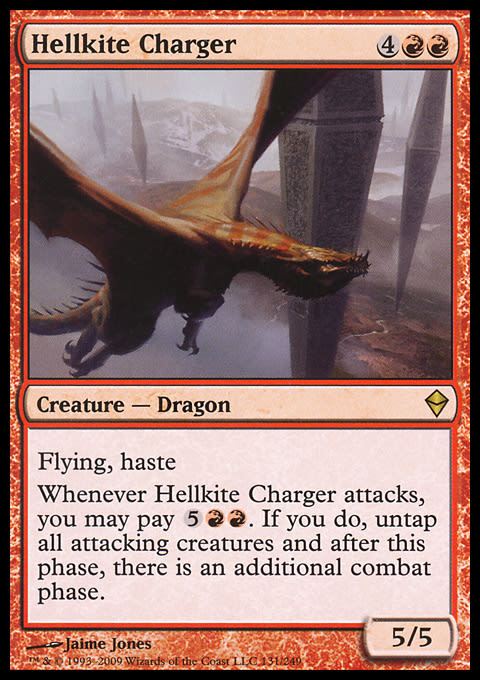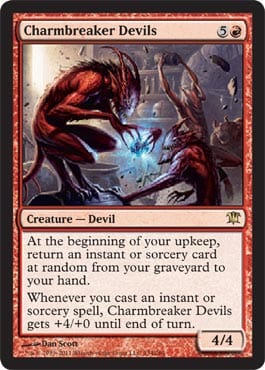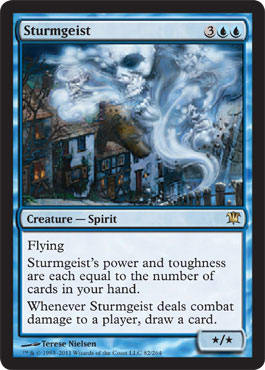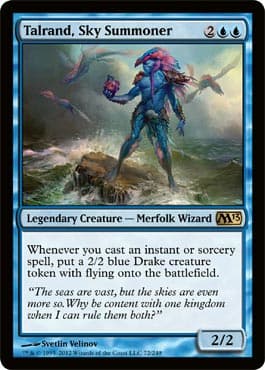Last week we took another stroll into Magic’s history through the lens of the Preconstructed. Starting with 1998’s The Sparkler, we traced the lineage of the Izzet (Blue/Red) from Stronghold all the way until Sidestep, released a decade later in Eventide.
One of the things that makes Magic such a bewitching game is that it’s always evolving, and has tremendous variety. Even within that single color pair, we saw lots of different approaches and strategies. There were variants in the “traditional” approach of turning creatures sideways and backing them up with spells, as with Battle Surge (1999, Urza’s Destiny) and Air Razers (2002, Judgment). Last week I called this the “Look how Red and Blue can do this” approach, because the decks do things any deck can do, just with an Izzet flavor.
The other type of deck was the “Look at what Red and Blue can do” approach. These were decks that showcased some of the quirkier or more unusual builds, things that were enabled by the pairing of these two colors. These sorts of decks included not only the aforementioned The Sparkler, but also Pulverize (2003, Scourge) which had a converted-mana-cost matters theme, and the time-bending Reality Fracture (2006, Time Spiral).
Today we’re going to cross over the threshold, leaving the land of Theme Decks and focusing on Intro Packs, which replaced them in 2008 with Shards of Alara. The Izzet combination proved to be particularly popular in the Intro Pack era, with fourteen decks making use of that color pair (versus nine over the slightly longer Theme Deck era). As you’ll see, it was especially popular with the Core Sets, and that brings us to our very first deck.
Year: 2009
Deck:Firebomber
Set: Magic 2010
Rares: Earthquake, Shivan Dragon
Magic 2010 heralded the triumphant return of the Core Set to Magic, featuring a black border and all-new cards. Sure, many of them were reskinned “functional reprints,” but the set generated a lot of excitement around a product line that had historically been rather bland. Of course, having Lightning Bolt return certainly didn’t hurt, either, and this otherwise very ordinary deck packed in a couple of them.
The early Intro Packs were 41-card affairs, which would last for a year until returning to 60 cards with Magic 2011. Interestingly, Firebomber’s entire creature complement was Red, and was a rather uninspired collection of generic Red threats like Goblin Piker, Canyon Minotaur, and Dragon Whelp. Even the deck’s rare creature, Shivan Dragon, was something we’d seen many times before. Same with Earthquake, the other rare card.
In terms of complexity and creativity, this wasn’t far off from a Sample Deck. But we wouldn’t have long to wait until they got better.
Year: 2009
Deck: Pumped Up
Set: Zendikar
Rares: Hellkite Charger, Rite of Replication
Zendikar, being an “expert” set, gave Wizards a few more tools to work with in crafting their theme decks. Magic 2010 represented a baseline of what the colors could do, since Magic 2010 had no designated mechanic (another thing that would change the following year), so it had little spice to season the decks with. In Zendikar, at least you had kicker.
It wasn’t much in terms of differentiation, but it did give some variety to stock effects as in Into the Roil and Burst Lightning. Here again, though, we saw Goblin Piker, Canyon Minotaur, Prodigal Pyromancer, Sleep, Fireball, and a closer in the form of a Dragon. Old deck, new wrinkle.
Year: 2010
Deck: Breath of Fire
Set: Magic 2011
Rares: Ancient Hellkite, Cyclops Gladiator
As mentioned above, Magic 2011 saw the merciful return of the 60-card deck for Magic’s entry level line of Preconstructed products. Not only did that give Breath of Fire a little room to breathe, but Wizards had also brought back scry as a “returning mechanic,” which would become standard practice for the new-era Core Sets. This gave it a bit of a Fate Blaster feel, the scry-employing Theme Deck from 2007’s Future Sight.
But more than that, they’d begun to design a little more creatively. Breath of Fire isn’t a radical reinvention of the U/R combat paradigm. You still attack with beaters, support with spells. But there were some card interactions introduced here which gave the deck a lot more depth. For instance, while the workhorse Prodigal Pyromancer made his third consecutive appearance here, his ability — always useful — felt more fresh and relevant with a pair of Chandra's Spitfires in the deck.
While the creature suite was again nearly monochromatic, we also saw a bit of the “spells matter” theme the Izzet is known for make itself apparent. Fire Servant doubled the damage of your Red instants and sorceries, while Call to Mind let you pull a spell back out of the graveyard. It wasn’t much, but it was enough. This deck felt leagues better than the very mediocre initial Izzet offerings, even if at the heart of it it was cut from similar cloth.
Year: 2010
Deck: Metalcraft
Set: Scars of Mirrodin
Rares: Argent Sphinx, Etched Champion
The upward trajectory continued with Metalcraft, named after the mechanic featured in the deck. Although this was still a “look how Red and Blue do this” type of deck, it had a huge difference in its artifact theme to make it feel fresh and new.
For one thing, you had very few spells to play with — a trio of Galvanic Blasts and a Disperse. Instead, the deck used that slots to load up on trinkets and equipment. That’s because this was what I often refer to as a “feast of famine” deck. These sorts of decks aren’t all that great in their natural state, but if you are able to jump through the right hoops, you flip a switch and “turn on” the deck, and your individual components go from below average to above.
And your reward for deploying all those artifacts? Your Etched Champion became nearly unkillable. Your Snapsail Gliders take to the skies. Your Argent Sphinx gets to flicker, and your Blade-Tribe Berserkers come in with the force of a Mack truck. All the while, your other cards like Golem's Heart and Riddlesmith offered incremental advantage for every artifact played on your way to powering up.
Year: 2010
Deck: Mirromancy
Set: Mirrodin Besieged
Rares: Galvanoth, Red Sun's Zenith
Although the quality of the Izzet’s Intro Packs had continued to tick upward with each successive release, Mirromancy represented a huge jump forward. It’s not that it was an amazing deck — indeed, it too suffered from some rather pedestrian inclusions like Koth's Courier and Ogre Resister — but rather because it was a huge departure from form. At last, we had our first “look what Red and Blue can do” contender.
Mirromancy took a page out of the playbook that guided decks like The Sparkler and Izzet Gizmometry (2006, Guildpact). It was lighter on creatures, and heavier on spells. You still had an army of seventeen, but a huge amount — and variety — of spells. Foresee and Preordain gave the deck a splash of “toolbox” strategy, letting you filter through cards until you found the situational singletons you were needing, like Crush, Rally the Forces, or Turn the Tide.
Or your Galvanoth.
Galvanoth was the nitrous in the deck’s tank. With a deck nearly a third-filled with spells, Galvanoth’s promise of netting you free castings made the deck a blast to play. Thanks to scry, you could even tilt the odds a bit in your favor, particularly with pricier cards like Sleep and Melt Terrain. A Fire Servant was included in the deck as well, promising to double the effectiveness of your burn, including Red Sun's Zenith.
All in all, you never quite knew what you’d get with Mirromancy. Players wanting consistency would be left disappointed, because you’d often find yourself throwing your spells at your opponent to try and slow down the inevitable, never quite finding enough to stabilize. But when the deck’s pieces fell into place, Mirromancy was an Izzet mage’s dream.
Year: 2011
Deck: Eldritch Onslaught
Set: Innistrad
Rares: Charmbreaker Devils, Sturmgeist
Ahh, what a time to be alive! If you loved the Izzet spellslinging archetype, Eldritch Onslaught was a gift from above. As expected, it sacrificed overwhelming creature advantage to make room for non-creature shenanigans, which is where a lot of the fun happens in world of the Izzet.
In this case, the featured mechanic was flashback, which had returned for Innistrad. But unlike sets where we’d seen a core mechanic dance around the periphery rather than feature in the fundamental strategy of the deck (looking at you, scry), Eldritch Onslaught poured it on. Through cards like Deranged Assistant, Armored Skaab, and Merfolk Mesmerist packed your graveyard, and you might well feel like you were playing Magic with two hands of cards instead of one.
If that wasn’t enough, Eldritch Onslaught took the best element of Mirromancy and included it, giving you a rare (Charmbreaker Devils) that synergized wonderfully with the theme of the deck rather than just being another closer. Finally, Burning Vengeance took you over the top, and you could be forgiven for cackling like a madman as you threw gouts of flame left and right, flashing back card over card you’d salted away in the larder.
Eldritch Onslaught wasn’t just an Izzet deck. It was a deck that succeeding in making you feel Izzet. It remains not just one of the best Izzet Preconstructed decks, but one of the all-time best of any colors.
Year: 2012
Deck: Depths of Power
Set: Magic 2013
Rares: Stormtide Leviathan, Talrand, Sky Summoner
The last deck we’ll look at today cemented this period as something of an Izzet renaissance. A common knock on Intro Pack decks was that they were disposable garbage, little more than collections of draft chaff with a mediocre foil rare slapped on the front. This era of Izzet design gives the lie to that, showing the tremendous care and thought that went into these decks — particularly when contrasted against the earlier entries discussed at the beginning.
Depths of Power was a 50/50 deck, with an equal number of creature and noncreature cards. It essentially split the difference between Eldritch Onslaught and Mirromancy, caring about spells a little bit less than the former, but able to stand on its own two legs a little better than the latter. To be sure, spells still mattered here, and the deck’s marquee rare, Talrand, Sky Summoner, set the tone. Every spell you cast upped your creature count with a free 2/2 Drake, and the fact that you could do this at instant speed gave you a lot of unpredictability and potential value (you could 2-for-1 your attacking opponent with a single Searing Spear by using the triggering Drake as an ambush blocker).
Augur of Bolas gave you further value out of your instants and sorceries, and its relative, the Mindclaw Shaman, even let you are about your opponent’s instants and sorceries! The Archaeomancer rounded out the spells-matter theme, acting as a Gravedigger for your expended spells.
Sure, the deck was a little more conventional on the creature front, with a Harbor Serpent and Stormtide Leviathan acting as your closers if you couldn’t get the job done in the air, but overall it struck a nice middle ground — and continued the string of clever iterations of Izzet deck design.
We’ll leave it here for the week, and we’ll kick off next week with a blast as we enter Return to Ravnica territory. Would the Izzet Renaissance continue, or will that return “home” mark the beginning of the end.
See you then!





































